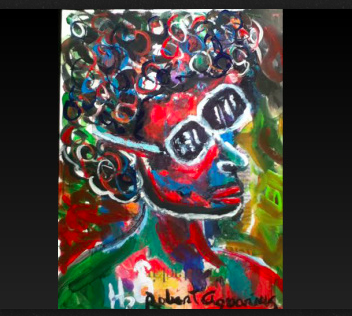Outfitted in a denim vest and jeans, the newest member of the Pirate Alley art community excitedly shows off his skillet paintings, three-dimensional art pieces featuring a sizzling breakfast rendered on a real skillet – just the right size to fit in your carry-on luggage.
It has only been a couple of weeks since he started showing his work in this spot, but Robert Aquarius loves it. The New Orleans native has sold and displayed his art throughout the city for years, but Pirate Alley and Jackson Square offer a special opportunity to reach out to visitors and have fun while making a bit of cash. He laughs often and jokes freely with everyone walking by his plot of fence.
But the work is nothing new. He’s been painting since the early 1990s, when, “broke and overweight,” he heeded the advice of a girlfriend who suggested he try it as a way to cure his depression. The relationship did not last, but art quickly became a central part of his life. Since that time, Robert’s created large-scale murals, small sketches to sell to visitors, even pieces of fruit rendered out of scrap metal. While he’s worked other jobs over the years – mostly service positions in the French Quarter – he considers painting his true vocation.

One of Robert’s paintings. Photo courtesy of Robert Aquarius, used with artist’s permission.
Re-imagining the Claiborne Underpass
In the early 2000s, Robert was commissioned along with a small group of other local artists to create a mural along the Claiborne Avenue Underpass. His mural winds its way around a large concrete pole below the highway, telling the history of the local African-American community from the slave trade to the present day. Brightly painted vignettes display bodies being thrown overboard along the slave passage, a white slavemaster knocking at a cabin door while a female slave waits on the other side and a civil rights march bursting with community members, before finally settling on a young woman in a cap and gown proudly displaying her diploma. He titled the “The Village Walking Stick” in honor of the story it tells.
A Chance to Chat
For Robert, making art is more than just a way to earn a living – it’s a way to relate to people. He treats his works of art like social objects – gifts to share with friends and visitors, artifacts that evoke the experience of being in New Orleans, conversation pieces for passersby wondering about the older African-American man selling rows of sizzling pans of sausage, bacon and eggs rendered in heavy acrylic paint. Photos are welcome, even encouraged, and friendly conversation can almost feel mandatory.
On this particular afternoon, the cold has kept many would-be New Orleans revelers inside, but the sparse crowds don’t faze Robert, who is ready to share a story with any passerby who shows the slightest interest in his work. Tentative questions from a young visitor about one piece quickly turn into an animated discussion about the culture and colorfulness of the city, with Robert rummaging through his haphazard pile of equipment to find a binder bursting with brightly colored faces he’s painted on old scrap newspaper. He flips it open and starts explaining the intricate process that led him to turn the paper from his mixing palettes into works of art.
“Have a free print,” he tells the woman. “I love giving them out.” “Besides,” he says, “in another few minutes, I’ll have to pack up my bags and cart my work home, and that makes one less piece to carry.” He pauses, smiles, then laughs, as the girl hesitantly collects her print, thanks him with a big smile of her own and walks down the street (Robert Aquarius, Interview by Jocelyn Horner, Jackson Square, March 17, 2014).





